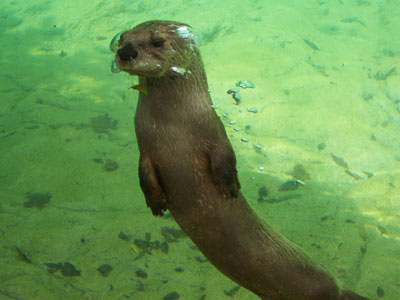|
back Home Life Along a
|
|
North American River Otter
Lutra canadensis|
© Dustin Holmes, www.flickr.com/photos/dustinholmes |
These playful mammals are returning to America’s rivers after being extirpated from many of their original native areas. Being sensitive to environmental pollution, their populations had dwindled. In recent years, biologists have reintroduced them to several river and wetland systems across the country, including Oklahoma. These transplanted otters are doing well and the species is recovering. They now can be found throughout Canada and the U.S. River otters construct dens from burrows abandoned by other animals or they use natural hollows. They are semi-aquatic, streamlined with short legs ending in webbed claws. They have thick tapering tails and long whiskers. Their long whiskers allow them to sense prey in these aquatic habitats where their other senses may be diminished. If you are looking for otter tracks, look for tracks that have 5 webbed, clawed toes and probably some of the tracks are rubbed out by their dragging tail. River otters can weigh more than 20 pounds and are about 1-1.25 m long. Typical habitats are lakes, rivers, coastal habitats, marshes, and swamps. These agile swimmers are able to stay under water for up to 8 minutes. They mainly eat other aquatic animals such as fish, turtles, and amphibians, but have been known to eat birds and other small terrestrial animals. River otters typically live 8 or 9 years in the wild. They usually live alone except for females and their young, who stay together until the pups are about 6 months old. |
|
back to species list |
PDF of all species profiles
|

